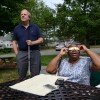What would you do with $454 million that must be spent in three years?
This is the question currently faced by the Boston Public Schools (BPS) as it collects community input on how to best spend a historic level of federal pandemic relief funding, a once-in-a-lifetime investment of nearly half a billion dollars that has the potential to make a lasting and significant impact.
But will it? In a district facing multiple challenges — from steadily declining enrollment to long-neglected facilities to more than one-third of its schools in the bottom 10 percent of the state — what guarantee do Boston residents have that history will, in fact, be made by this extraordinary boost in funding?
The chance to make history should never be taken lightly, and the investment of $454 million over three years could transform a system like Boston, which is badly in need of a booster shot. At long last, we have the funds so many of us working in education have advocated for and dreamed about, with a federal mandate to address learning loss and address the pandemic’s disproportionate impact on underrepresented student groups. With these goals in mind, we must consider the following:
- The need for social and emotional support for our 51,000 BPS students has never been greater, and it is long past time to ensure that all of our students are receiving the counseling and services they need in order to thrive inside and outside of the classroom. Staffing of licensed clinicians should be based on a school’s population, with student-to-counselor ratios falling within recommended state benchmarks.
- Every caring adult knows how valuable one-on-one attention is for a child. With 20% of the federal funding (or about $55 million) specifically earmarked to cover the loss of in-person classroom time for Boston students — most of whom had reduced instructional time over a span of 14 months — Boston should employ high-dosage tutoring, an effective, research-based strategy that could help more BPS students to catch up or reach grade level.
- Boston already faced a childcare crisis before COVID-19 hit. With equity and quality as the centerpieces of our implementation strategy, we must expand existing early education programming to all of the city’s 3- and 4-year-olds. To date, we have fallen short in lifting up our most vulnerable students, and we have the ability — by providing a high quality, intervention-based framework — to help mitigate some of the challenges faced with a later entry to school. The provision of robust programming — and the ability to address delays in speech, cognition and motor skills at the earliest possible moment — will inevitably place more of our most vulnerable students on a pathway to success. The addition of these seats will also serve to boost the district’s ongoing decline in student enrollment.
- As part of our needed expansion of early education seats, BPS should begin to use the Adverse Childhood Experience (ACE) framework as a diagnostic for all students entering the school system. Today, more than 76% of Boston students are identified as “high needs.” Utilizing ACE as an entry point allows school staff to provide incoming students with the support they may need — whether it is emotional, academic or preventative — to create a healthier, more holistic plan for individualized student attention.
- If we truly mean what we say about equity, the district must address the significant gaps and lack of opportunities faced by the district’s students with disabilities and English learners, both of whom make up a significant percentage of the BPS enrollment. We need more inclusive classrooms, a far better assignment process, access to after school options and specific, high quality programming to better serve these students in-district.
- Finally, we must revisit the long-buried efforts on high school redesign with a view that looks beyond the city’s three exam schools, which educate less than 30% of the district’s enrolled high schoolers. A comprehensive redesign effort, one that welcomes family and student voices, is a worthy endeavor. Do we need another arts academy? Can we add green tech as well as robust internship opportunities for every student at Madison Park? With only one designated vocational technical school in Boston, our students need and deserve a shining star such as Worcester Tech, among other high school options, that will capture their imagination and interests.
A $454 million investment, spent wisely in the next three years, could absolutely pave the way toward the goals of quality and equity in all of our Boston schools, and the city can no longer afford to ignore the bellwether before them and to deny these critical investments in the future of Boston’s children. And with the Department of Elementary and Secondary Education’s 2020 audit of the BPS citing everything from organizational disarray to high schools in need of graduation standards, now is the time to make the necessary investments so many of us have longed to see.
Mary Tamer is a Boston Public Schools graduate, a former BPS parent and a longtime parent leader and volunteer. She served on the Boston School Committee under Mayor Thomas Menino from 2010-2014 and earned her master’s in Education Policy and Management from the Harvard Graduate School of Education. She is a candidate for Boston City Council in District 6.




